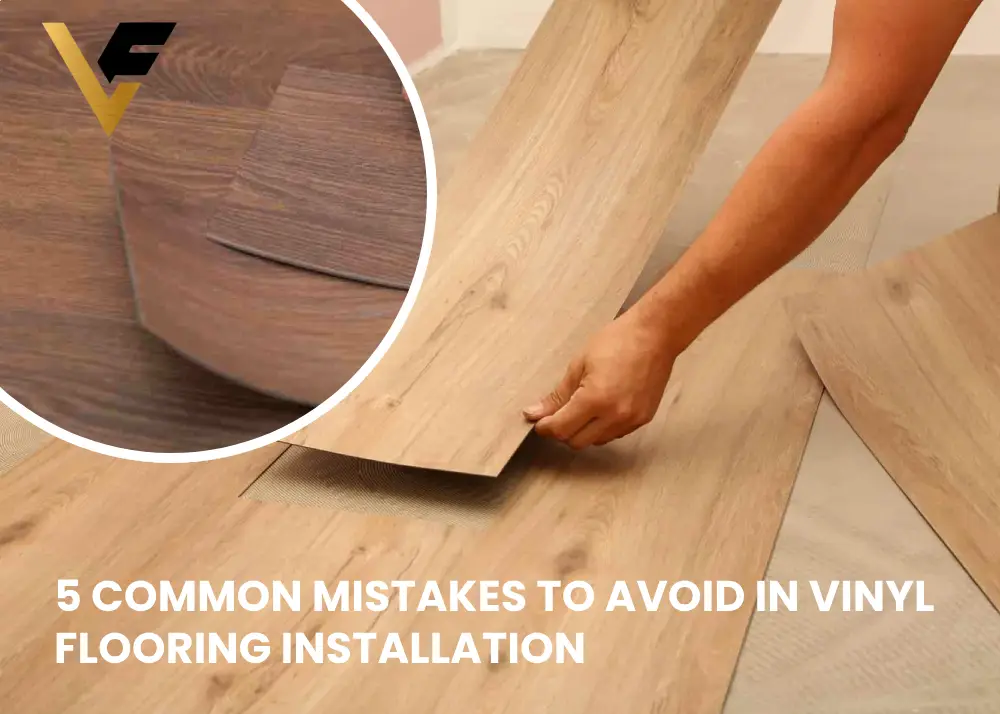Vinyl flooring is a popular choice for homeowners due to its durability, affordability, and variety of design options. However, improper installation can lead to a range of issues that could compromise its performance and appearance. To help you achieve the best results, here are 5 Common Mistakes to Avoid in Vinyl Flooring Installation.
1. Inadequate Subfloor Preparation
Importance of Subfloor Preparation
A well-prepared subfloor is crucial for a successful vinyl flooring installation. An uneven or improperly prepared subfloor can cause numerous problems such as bumps, gaps, and premature wear and tear.
Common Issues with Subfloor Preparation
- Uneven Surfaces: Vinyl flooring requires a smooth, flat surface. Any unevenness can lead to visible bumps and potential damage over time.
- Debris and Dirt: Leftover dirt and debris can prevent the vinyl from adhering properly, leading to peeling and bubbling.
- Moisture: Excessive moisture can cause vinyl flooring to lift and curl, and in some cases, lead to mold growth.
How to Properly Prepare the Subfloor
- Clean Thoroughly: Sweep and vacuum the subfloor to remove all dust, dirt, and debris.
- Check for Moisture: Use a moisture meter to ensure the subfloor is dry. If moisture is present, address the issue before proceeding.
- Level the Surface: Use a leveling compound to fix any dips or high spots. Follow the manufacturer’s instructions for the best results.
- Remove Old Flooring: If installing over existing flooring, make sure it is in good condition, flat, and securely adhered.
2. Ignoring Acclimation Requirements
Importance of Acclimation
Vinyl flooring needs to acclimate to the room’s temperature and humidity before installation. This process allows the material to expand or contract as needed, preventing issues after installation.
Consequences of Skipping Acclimation
- Expansion and Contraction: Without proper acclimation, vinyl flooring may expand or contract after installation, leading to gaps or buckling.
- Misalignment: Changes in the dimensions of the flooring planks can cause misalignment, making the installation look uneven.
How to Acclimate Vinyl Flooring
- Check Manufacturer Guidelines: Follow the specific acclimation instructions provided by the manufacturer.
- Store in the Installation Area: Place the vinyl flooring in the room where it will be installed for at least 48 hours. Ensure it lies flat and is exposed to the room’s conditions.
- Maintain Room Conditions: Keep the room at a consistent temperature and humidity level during the acclimation period.
3. Incorrect Measurement and Layout
Importance of Accurate Measurements and Layout
Accurate measurements and a well-planned layout are essential for a professional-looking installation. Mistakes in this stage can result in wasted materials and a poor final appearance.
Common Measurement and Layout Mistakes
- Incorrect Room Dimensions: Misjudging the size of the room can lead to purchasing too much or too little material.
- Poor Planning of Plank Placement: Failing to plan the placement of planks can result in unsightly seams and patterns.
- Not Allowing for Expansion Gaps: Vinyl flooring needs room to expand and contract. Skipping this step can cause the floor to buckle.
How to Measure and Plan Properly
- Measure the Room Accurately: Use a tape measure to get precise dimensions of the room. Account for any alcoves or irregularities.
- Plan the Layout: Sketch the room and plan the placement of the planks. Aim for a balanced look by staggering the seams and avoiding small pieces at the edges.
- Include Expansion Gaps: Leave a 1/4 inch gap around the perimeter of the room to allow for expansion and contraction.
4. Incorrect Use of Adhesive
Importance of Proper Adhesive Use
Using the right adhesive and applying it correctly is critical for the longevity and stability of vinyl flooring. Improper adhesive use can lead to peeling, bubbling, and other issues.
Common Adhesive Mistakes
- Using the Wrong Adhesive: Not all adhesives are suitable for all types of vinyl flooring. Using the wrong one can compromise the bond.
- Applying Too Much or Too Little Adhesive: Too much adhesive can cause it to seep through seams, while too little can lead to lifting and gaps.
- Not Allowing Proper Drying Time: Not giving the adhesive enough time to set can result in movement and misalignment of the flooring.
How to Apply Adhesive Correctly
- Select the Right Adhesive: Check the manufacturer’s recommendations for the appropriate adhesive type.
- Follow Application Instructions: Apply the adhesive evenly using the recommended trowel size. Ensure consistent coverage without excess.
- Allow Proper Drying Time: Follow the manufacturer’s drying time instructions before walking on or placing furniture on the floor.
5. Neglecting Finishing Touches
Importance of Finishing Touches
The final touches can make or break the appearance and functionality of your vinyl flooring. Properly finishing the edges, seams, and transitions ensures a polished look and prevents damage.
Common Finishing Mistakes
- Skipping Transition Strips: Failing to use transition strips between different flooring types can result in uneven edges and trip hazards.
- Improper Sealing of Edges: Leaving edges unsealed can allow moisture to seep under the flooring, causing damage.
- Neglecting Baseboards and Trim: Not reinstalling or properly fitting baseboards and trim can detract from the overall appearance.
How to Finish Properly
- Use Transition Strips: Install transition strips between rooms and different flooring types for a seamless and safe transition.
- Seal the Edges: Use a silicone sealant to seal the edges of the flooring in moisture-prone areas such as kitchens and bathrooms.
- Reinstall Baseboards and Trim: Carefully reinstall baseboards and trim, ensuring they cover any gaps and enhance the finished look.
Conclusion
5 Common Mistakes to Avoid in Vinyl Flooring Installation can be a straightforward and rewarding project if done correctly. By avoiding these common mistakes, you can ensure a smooth installation process and a beautiful, durable floor that will last for years. Proper preparation, careful measurement, and attention to detail at every step will help you achieve professional results. Happy flooring!


